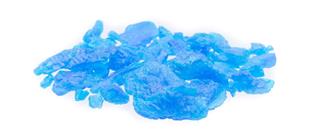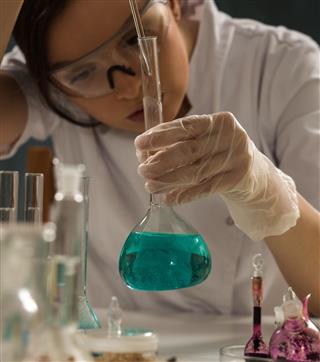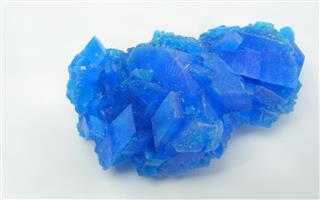
Read this article to gain more information about the uses and applications of the compound called copper sulfate.
Copper sulfate, also known as ‘blue stone’ or ‘blue vitriol’, is a chemical compound that is used in a wide range of industries. The basic chemical formula of blue vitriol is ‘CuSO4‘, but the salt exists as a series of different compounds, depending on the degree of hydration. ‘Chalcocite’, the anhydrous form of copper sulfate, occurs as a rare mineral and exists as a pale green or grayish-white powder.
The various hydrated forms of copper sulfate include trihydrates, pentahydrates, and heptahydrates. However, copper sulfate pentahydrate (CuSO4.5H2O) is the most commonly found salt. It is bright blue in color and is known as ‘chalcanthite’. This color of the crystals is due to the presence of water of crystallization, and is the best way to distinguish between the anhydrous and hydrated forms.
Copper sulfate can be prepared in the laboratory by reacting various compounds of copper (II) with sulfuric acid. However, it is commercially available on a large-scale basis, and is an economic source of Cu. Copper sulfate pentahydrate readily dissolves in water and is also soluble in methanol, glycerol, and to some extent in ethanol. When the blue crystals of copper sulfate are heated in an open flame, they get dehydrated and turn grayish white.
Uses
Copper sulfate is a versatile chemical compound having a wide range of applications in agriculture, as well as pharmaceutical and chemical industries.
Agriculture
- Copper sulfate pentahydrate is commonly used as a fungicide to control various bacterial and fungal diseases of crops, fruits, and vegetables, such as mildew, leaf spots, blights, and apple scab.
- Mixture of copper sulfate and ammonium carbonate, known as Chestnut compound, is used as a soil sterilizer or in horticulture to prevent seedlings from getting damp.
- It is used in the preparation of Bordeaux mixture, along with lime, which is utilized for leaf application and seed treatment for treating fungal diseases on grapes, melons, and other berries.
- Copper sulfate pentahydrate is used as a molluscicide, to repel and kill slugs and snails.
- It as an algaecide to prevent algal growth.
Chemical Industry
- Copper sulfate is often used in the preparation of catalysts for several reactions in many industries.
- The anhydrous form of this salt catalyzes many processes like the transacylation in organic synthesis.
- It is used in purification of gases by removal of hydrogen chloride and hydrogen sulfide.
- The application of copper sulfate in preparation of dyestuff intermediates and catalyzing the synthesis of diazo compounds and pthalocyanine dyes is very common.
- Copper sulfate is used as an electrolyte in electroplating and also used in some precipitation reactions.
- It is utilized as an additive in adhesives.
- Copper sulfate serves as a coloring agent for glass, cement and ceramics.
- This salt is also used in many chemistry sets for undertaking various experiments.
Public Health and Medicine
- Copper sulfate is used as a fungicide not only in agriculture, but also as an antiseptic and germicide against fungal infections in humans.
- Incorporating this salt in floor cleaning mixtures helps in preventing athlete’s foot in tropical countries.
- Copper sulfate is used in the preparation of Paris green, to kill mosquito larvae that cause malaria.
- It is used to keep algal blooms away, especially from the swimming pools and water reservoirs.
- Copper sulfate helps in eradicating snails that harbor the parasite responsible for causing Schistosomiasis in humans.
Apart from the above uses of copper sulfate, this compound is also used in preparation of wood preservatives to protect timber from wood worms. It is also utilized as a mordant in dyeing, and as a reagent in tanning process. Moreover, growing crystals of this salt is one of the common science fair projects for middle school and high school children.


